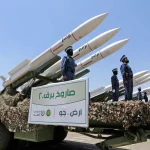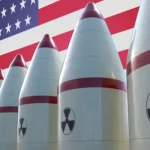The collapse of the missile defense talks and President Medvedev’s recent statement in which he warned that Russia would consider serious response measures highlighted the fact that the US and NATO switched the arms race to a new mode rather than quited it following the demise of the Soviet Union. The Western agenda behind the resumed arms race is to neutralize Russia’s nuclear deterrent and to create conditions under which an aggression against the country could be launched without fear of retaliation.As a result, the economic and political strengthening of Russia which commenced in the 2000s is seen in the West as a challenge.In fact, the US Administration perceives as a threat the existence of any sufficiently strong and independent country defying the US dictate and not bowing to the US interests. Naturally, Russia is permanently in the spotlight in this regard.
The aggressive character of the US international policies stems from profound causes, and Moscow should shed any illusions that the US would ever consent to an equal partnership with assertive Russia. There are no reasons to hope that Washington would ever abandon attempts to undermine Russia’s nuclear potential, and the whole episode around the European defense should be viewed as just one in a series of past and future similar developments.
The US persistence in building a missile shield and the resulting threat to Russia’s nuclear capabilities leave Moscow no choice but to formulate an adequate response. Essentially, the US provokes Russia to join the arms race, and it appears unlikely that Russia can adequately safeguard its national security without getting involved picking up the challenge. What Russia can and should do, however, is to avoid a replay of the unfavorable Cold-War era confrontation scenarios and the risks similar to those they engendered. Moreover, Russia can confront the US with an arms race model that would be sure to make Washington wince.
Risks Embedded in Symmetrical Responses. As long as the US continues to impose the logic of the arms race Russia is being drawn into, Moscow will be facing disadvantaging political, economic, technological, and military terms. By opting for a symmetric response, Russia would enter a risky and exhausting competition which would burden it harder than its rivals. Consequently, Russia’s imperative – in handling the missile defense problem and in formulating its wider defense policy – is to search for efficient but relatively low-cost asymmetric solutions. It should be taken into account in the context that Russia has an impressive array of ideas and designs that should help it maintain the asymmetric strategic parity with its tentative adversaries. The asymmetric measures must not be limited to the military sphere – Moscow should take synchronous and similarly asymmetric steps in the wider international politics, diplomacy, etc.
The Risk of a New Full-Scale Cold War. In all cases, Russia should avoid full-blown protracted confrontations with the West. The task is completely realistic given that Moscow adheres to reasonable deterrence policies. The epicenters of the looming arms race have drifted from West Europe closer to Russia’s frontiers – to Poland, Romania, the Czech Republic, Bulgaria, and Turkey. The importance to the “old” Europe of the energy business it is doing with Russia is a factor that will likely keep Europe fairly disunited over the arms race against Russia and likewise pursuits that might antagonize Moscow. Fostering the international anti-war movements could also be a good idea for Russia.
China is Russia’s potential ally in the arms race. No doubt, Beijing is seriously concerned over the missile defense systems deployed in Alaska and California, which are equipped with GBI interceptors, as well as in Japan and on the SM-3 interceptor-equipped US Aegis-class ships patrolling the seas in the proximity of China. China has several response options, every one of them promising huge additional military spendings to Washington. China already being among the world’s economic heavyweights, its administration naturally has to plan to upgrade the country’s defense accordingly and to be ready for some arm-wrestling with the US in the process.
The Risks of Overstraining the Russian Economy. This type of risks are inherent in the symmetric response strategy and can be avoided based on the proper asymmetry and strict implementation of the defense sufficiency doctrine. An asymmetric response would drive technological innovation in Russia, both within its military-industrial complex and across the national economy. The economy of today’s Russia is free of a range of ills that used to drag down the Soviet Union in the arms race. By opening the channels for advanced technology transfer from the military to civilian sectors as a part of its fairly efficient regulated market economy and state capitalism, Russia can actually give a boost to its necessary general economic modernization.
Paradoxically, Moscow could benefit from the strategy of converting the arms race induced by Washington’s current steps into a race of innovations. Russia has the bulk of key nuclear and missile technologies and therefore need not worry about being defeated in the competition. The Soviet technological legacy provides a solid basis for Russia’s broad technological advancement, the case of GLONASS being a prime example.
It is clear that wider socioeconomic progress and governance improvement are prerequisites for Russia’s economic stability. Reinforcing the national defense is a mission that could help the country get focused on both tasks.
The Risks Posed by Psychological and Informational Warfare Being Used to Discredit Russia Internationally. Back during the Cold War as well as in the post-Soviet epoch the US declined to open an honest dialog with the USSR/Russia as an equal partner. The traditional US approach was to throw in unforeseen demands at every phase of negotiations and to attempt to outplay Russia by planting technical and legal ambiguities in the agreements signed, pressing for linkages between disarmament and general policy issues, loosely interpreting the deals, and resorting to informational warfare. Talks over the European missile defense and the US treatment of the Conventional Arms in Europe Treaty vividly illustrated the above.
The developments around the CFE in Europe added up to a lesson that Russia must learn diligently. The US and NATO cited the Treaty to coerce Russia into withdrawing its forces from Georgia and Transnistria even though the agreement contained no such requirements, and then refused to add the armaments of new NATO members to the CFE balance. When, as a result, Moscow suspended the Conventional Arms in Europe treaty on December 2007, the US and NATO nevertheless blamed on Russia the collapse of the deal.
Russia should be cautious not to make the same mistakes in negotiating tactic and the related informational campaigning that the Soviet Union used to make. Excessive secrecy around the response measures would make it hard to spell out to the rest of the world the rationale behind them. The untamed Soviet secretiveness routinely gave Washington advantages in feeding its own interpretations to the international community.
Due to the challenge posed by the US missile defense, the tasks discussed herein can already be thought of as integral elements of the Russian agenda. The condition to be met to par the pertinent risk was formulated with utmost clarity by Gen. L.G. Ivashov who wrote:
“A certain pattern can be discerned in the relationships between the USSR (Russia) and NATO. Compromises that take shape of treaties and agreements are only achievable given the power dominance of the eastern party, or at least in conditions of parity of force. That was the case of anti-missile defense shield in Europe, SALT-1, SALT-2 (reduction of strategic warms), SNF-1 and SNF-2 treaties, INF and some other agreements…when it came to negotiations on limitation of reduction of armaments on an equal footing, given the West sensed its overpowering might, it was never willing to conclude such agreements.”
The observation must be credited with absolute realism. The purpose of Russia’s deterrence policy is to force the US Administration to treat Russia as an equal partner in the disarmament sphere and to act with due responsibility internationally. This can be done provided that Russia has enough military power.
Source: Strategic Culture Foundation














Comments